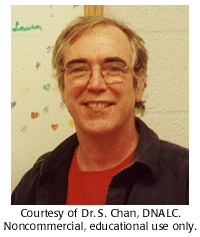முதன்மை மரபணுக்கள் அடிப்படை உடல் திட்டங்களைக் கட்டுப்படுத்தும்.


 Eric Wieschaus and Christiane Nüsslein-Volhard isolated and characterized many of the genes necessary for early embryonic development in Drosophila. Ed Lewis characterized one of the first homeotic mutations.
Eric Wieschaus and Christiane Nüsslein-Volhard isolated and characterized many of the genes necessary for early embryonic development in Drosophila. Ed Lewis characterized one of the first homeotic mutations.
Eric Francis Wieschaus (1947-)

Eric Wieschaus was born in South Bend, Indiana in 1947. His family moved to Birmingham, Alabama when he was six. He grew up without any special interest in science. He spent his free time painting and sketching; his ambition was to become an artist.
This all changed when he participated in a summer program funded by the National Science Foundation. The program brought bright teens together and encouraged them to consider careers in science by sponsoring their internship in science laboratories. Wieschaus enjoyed the camaraderie of fellow students, and was given a chance to work in a neurobiology lab. He didn't believe that what he did in the lab produced much data, but he was so interested in the "scientific" process and interacting with other science "geeks" that he decided to study science in college.
Wieschaus went to Notre Dame and majored in biology. As a way to earn money, he took a job making fly food in Harvey Bender's Drosophila lab. Here he learned the basics about fruit flies, but he was much more interested in embryology, and questions like: "how do cells know what to do as an embryo develops?", "what drives differentiation and development?"
Wieschaus thought he might not have a chance to find out because just as he was finishing college, the Vietnam War started. He applied for conscientious objector status, and decided to go to graduate school at Yale University while he waited to see if he would be drafted. Harvey Bender intervened on his behalf and wrote to Donald Poulson, a Drosophila geneticist at Yale. Poulson took Wieschaus on as a grad student sight unseen.
It was a stroke of luck to be in Poulson's lab because Poulson did a lot of the work on Drosophila embryogenesis. Poulson was about to retire, so Wieschaus wasted no time to learn as much as he could from him. After about a year, Poulson sent Wieschaus to Walter Gehring, who was just starting a fly lab at Yale. Poulson was able to retire and Wieschaus found himself in the enviable position of being the only graduate student in a new lab. He and Gehring worked closely together and Wieschaus finished his Ph.D. in 1974. By this time, he was in Basel, Switzerland where Gehring's lab had moved, and Wieschaus planned to go to Zurich, Switzerland, to do post-doctoral work. Before he left, Christiane Nüsslein-Volhard came to Basel and the two of them began talking about possible experiments.
In 1978, Wieschaus was offered a job at the newly established European Molecular Biology Laboratory (EMBL) in Heidelberg. Nüsslein-Volhard had been offered a job there as well, and the two of them were able to collaborate on the experiments they had talked about in Basel. They carried out large-scale mutagenesis experiments to find developmental Drosophila mutants. The result of their work was a new understanding of the mechanism involved in early Drosophila development. Wieschaus and Nüsslein-Volhard shared the 1995 Nobel Prize for their work with Ed Lewis.
In 1981, Wieschaus accepted a position at Princeton University and he has been there ever since. His research continues to focus on development, specifically on changes in cell shape during the various developmental stages.
Wieschaus believes that his early passion for art enhanced his ability as a scientist especially when it comes to "seeing" things. He still paints and does much of the image editing and presentation work of data from his lab. Wieschaus also does all the food preparation for his family, and spends his commuting time - he usually bikes to work - planning nutritious and practical meals.


Ed Lewis worked on the bithorax complex for over a decade. Most people in the Drosophila field already knew the results from various meetings before Lewis submitted the paper for publication.

How many genes would it take to "build" a living organism?
 டி.என்.ஏ. குரோமோசோம்களுக்குளிருக்கும்
டி.என்.ஏ. குரோமோசோம்களுக்குளிருக்கும் உயர்ந்த செல்கள் ஒரு பண்டைய குரோமோசோம்களை ஒருங்கிணைக்கும்.
உயர்ந்த செல்கள் ஒரு பண்டைய குரோமோசோம்களை ஒருங்கிணைக்கும். சில டிஎன்ஏ'கள் புரதத்தைச் குறியிடாது.
சில டிஎன்ஏ'கள் புரதத்தைச் குறியிடாது. சில டிஎன்ஏ'கள் தாவும்.
சில டிஎன்ஏ'கள் தாவும். மரபணுக்களைச் செயல்படுத்தவும், செயலிழக்கவும் செய்ய முடியும் .
மரபணுக்களைச் செயல்படுத்தவும், செயலிழக்கவும் செய்ய முடியும் . மரபணுக்கள் இனங்களுக்கிடையே நகர்த்தமுடியும்.
மரபணுக்கள் இனங்களுக்கிடையே நகர்த்தமுடியும். டிஎன்ஏ செல்கள் வெளியிலிருந்து வரும் சிக்னல்களுக்கு செயல்படும்.
டிஎன்ஏ செல்கள் வெளியிலிருந்து வரும் சிக்னல்களுக்கு செயல்படும். பல்வேறு செல் வகைகளில் வெவ்வேறு மரபணுக்கள் செயல்பட்டிருக்கும் .
பல்வேறு செல் வகைகளில் வெவ்வேறு மரபணுக்கள் செயல்பட்டிருக்கும் . முதன்மை மரபணுக்கள் அடிப்படை உடல் திட்டங்களைக் கட்டுப்படுத்தும்.
முதன்மை மரபணுக்கள் அடிப்படை உடல் திட்டங்களைக் கட்டுப்படுத்தும். மேம்பாடு, செல்களின் வளர்ச்சி மற்றும் மரணத்தைச் சமப்படுத்தும்.
மேம்பாடு, செல்களின் வளர்ச்சி மற்றும் மரணத்தைச் சமப்படுத்தும். மரபணுக்களின் ஓர் தொகுப்பே ஒரு மரபுத்தொகுதியாகும்.
மரபணுக்களின் ஓர் தொகுப்பே ஒரு மரபுத்தொகுதியாகும். உயிரினங்கள் பொதுவான மரபணுக்களைப் பகிர்ந்து கொள்ளும்.
உயிரினங்கள் பொதுவான மரபணுக்களைப் பகிர்ந்து கொள்ளும். மனித மரபுத்தொகுதியைப் புரிந்துக்கொள்ள டிஎன்ஏ ஓர் ஆரம்பம் மட்டுமே!
மனித மரபுத்தொகுதியைப் புரிந்துக்கொள்ள டிஎன்ஏ ஓர் ஆரம்பம் மட்டுமே!